All About Raw Dog Food
10/25/17
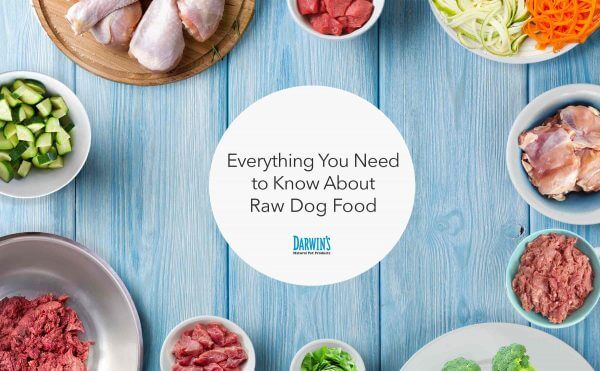
Last Updated on
Inside This Article
- What Is a Raw Dog Food Diet?
- Types of Raw Dog Food Diets
- Pros and Cons of Raw Dog Food Diets
- Tips on Preparing Own Raw Dog Food
- Transition Check Lists
- What to Look for in Raw Dog Food Brands
Raw Dog Food: Is It the Right Choice for Your Pet?
Dog owners who want to do what’s best for their companion animals inevitably think about why, how, and when they feed their pets. This interest has led to understanding which diets are best for a dog’s optimum health — and raw, natural diets are showing a winning edge. In this article, you’ll find expert information from a noted holistic veterinarian, the pros and cons of raw food, how to prep it at home, and a comprehensive buyers guide to raw dog food commercial brands.
What’s a Raw Dog Food Diet?
Raw dog food is what it sounds like: food served in its natural form, including uncooked meats, edible bones, and animal organs.
To help explore different aspects of raw feeding for pet dogs, we asked an expert to weigh in so you can decide if it’s is right for you and your dog based on what he’s learned in over 32 years of veterinary practice.
 Dr. Will Falconer is a Certified Veterinary Homeopath who practices worldwide from his clinic in Austin, Texas. He received his DVM from the University of Missouri-Columbia in 1980 and took the first Professional Course in Veterinary Homeopathy in Eugene, Oregon in 1992. His practice has been devoted to solely homeopathy ever since. Falconer keeps an active blog and website at VitalAnimal.com, inspiring animal owners to advocate for their pets and think deeply about medical practices falling under the heading of prevention, including ongoing free information. Writing and teaching on natural animal health is his passion.
Dr. Will Falconer is a Certified Veterinary Homeopath who practices worldwide from his clinic in Austin, Texas. He received his DVM from the University of Missouri-Columbia in 1980 and took the first Professional Course in Veterinary Homeopathy in Eugene, Oregon in 1992. His practice has been devoted to solely homeopathy ever since. Falconer keeps an active blog and website at VitalAnimal.com, inspiring animal owners to advocate for their pets and think deeply about medical practices falling under the heading of prevention, including ongoing free information. Writing and teaching on natural animal health is his passion.
The origins of the raw dog food diet begin with what canines ate in the wild before domestication. Dr. Falconer notes, “We know from genetic mapping that domestic dogs share some 99 percent of their genes with the wolf, their nearest wild cousin and ancestor.”
The Ancestral Dog Food Diet
Before dogs became our companions about 10,000 years ago, wild canines survived by stalking, killing, and eating live prey, carcasses, vegetation, and sometimes eggs. This ancestral diet contained favorable enzymes, vitamins, minerals, and other characteristics of unprocessed meat protein, fruits, and vegetables.
Once dogs joined our “tribe,” and before the birth of the commercial pet food industry about a hundred years ago, people fed dogs food scraps and raw meaty bones. Eventually, processed, convenience foods took the place of raw, and the diet of our pets changed along with ours.
When you get down to the facts, the ancestral diet far outstrips kibble (or dry dog food) in nutritional richness.
CALORIC CONTRIBUTION: ANCESTRAL DIET VS. TYPICAL DRY DOG FOOD
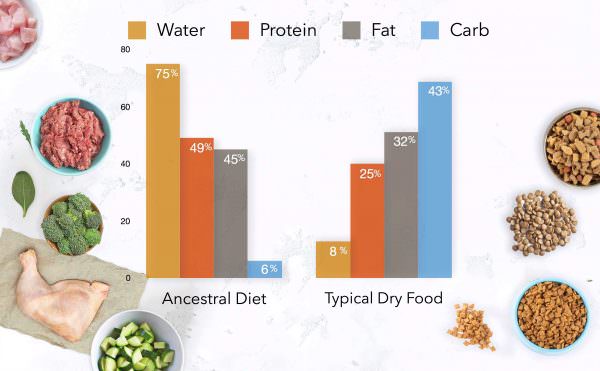
Different Types of Raw Food Diets for Dogs
There isn’t just one possible raw food diet for dogs. There are three main variations:
- Meat with Bone Diet. Veterinary Surgeon Tom Lonsdale, was one of the earliest advocates of feeding animals a species-appropriate diet and detailed it in his 1992 book “Raw Meaty Bones: Promote Health”. While Dr. Lonsdale recommends that the bulk of the diet should consist of “raw meaty bones” or carcasses when available, it also allows for table scraps, both cooked and raw.
- B.A.R.F. [Biologically Appropriate Raw Food] Diet. Ian Billinghurst proposed that in order to maximize your dog’s health, longevity, and reduce allergies and vet bills, you need to Give Your Dog a Bone. The BARF diet consists of 60 to 80 percent raw meaty bones, meaning bones that are about 50 percent meat. The remaining 20 to 40 percent should be comprised of fruit and vegetables, meat, offal, eggs, or dairy foods.
- Prey Model Diet. This diet’s goal is to simulate the proportions of prey animals that would naturally be eaten in an animal’s diet in the wild. Whole prey is used whenever possible, including chickens, game hens, turkeys, and whole rabbits. The diet recommends 80 percent meat (including some organs), 10 percent bone, and 10 percent organs (half is liver). The Prey model advocates feeding dogs meats from a wide variety of animals. Small amounts of vegetable matter are also included to help simulate the consumption of stomach contents.
There are varying opinions and questions about the components of a raw dog food diet for companion dogs. Judging the relative merits needs to begin with a clear-eyed view of the benefits of raw food for dogs overall.
The Pros of Raw Food Diets for Dogs
In a way, the question became ”What’s good about commercial pet food for dogs?” after 2007, when reports of renal failure in pets due to melamine contaminated pet food hit the news. That’s when many conscientious pet owners turned their interest to raw, more natural food.
“Feeding raw food is, most importantly, speaking to the genetic heritage of the dog. Genetically speaking, you are feeding a wolf,” says Dr. Falconer. “We have not specifically selected a new digestive system in domesticating dogs from wolves, so the call from within, the call of the genes is, Where’s the prey? That’s what all my ancestors and wild cousins ate and still eat today.” Dr. Falconer goes on to say, “The chief benefit, then, is feeding the most species appropriate food which means your dog grows as healthy and vital as possible.”
There are multiple benefits to raw feeding, including:
- Increased Energy. Improved nutrition boosts vitality.
- Healthier Coat and Skin. Many dogs have skin problems, and if food allergies are the culprit, a low-grain, more natural diet can bring relief.
- Weight Control. You may be able to feed more while keeping calories low because of the high-water content in raw food.
- Improve Common Conditions. Many dog owners who have switched to raw see common diseases and conditions like diabetes and arthritis improve soon after they start on a raw diet.
- Less Odor. Improved digestion, fresher breath, and smaller and almost odorless feces.
- Greater Longevity. Extended life and improved quality of life.
Dry and canned pet foods for the most part are created for the pet owner’s convenience and maximum shelf life, rather than the health or genetic predisposition of dogs. While true peer-reviewed scientific research on overall pet health is scarce, anecdotal evidence from pet owners, animal experts, and veterinarians support the significant health benefits noted above.
If that’s true, then what’s the beef with raw dog food?
The Cons of Raw Dog Food
Most research on raw diets focus on the unlikely microbial risks of all raw meats, rather than the content of the food itself. It should be noted that the few studies that do exist have been partially sponsored by (mostly dry) dog food companies.
“There are no greater risks with raw food than kibble in my mind. Both have been recalled for salmonella, for example,” says Dr. Falconer. “Though, the big food brands rarely make headlines for this, while the small competitors who make raw food get press.”
The risk of foodborne disease is quite low for dogs; It’s greater for a dog’s human caretakers — not the pet. Dr. Falconer notes that prevention is all about common sense. “If basic hygiene — wiping down surfaces where prep took place, running the food dishes through a dishwasher, and washing hands after handling raw food — is practiced there should be no issue with raw feeding,” he adds.
There are a few other possible issues to consider, but none of them are insurmountable:
- Potential Nutritional Imbalance. Home-prepared raw diets can lack some vitamins and other nutrients. There are holistic recipes available online that offer specific guidelines, and best-of-breed commercial brands include supplemental nutrients.
- Feed Bones with Caution. As carnivores, it’s natural for dogs to eat bones. Raw bones are good for dental health and prevent plaque buildup and gum disease. They also supply trace minerals. However, cooked bones from fish and meat tend to break into shards and should be avoided. Don’t feed weight-bearing bones such as a femur, because they can break teeth and cause digestive issues. If you feed raw marrow bones, once the marrow is gone, the bone can become stone-like and may result in possible damage to teeth, too. Be alert to marrow-free bones or avoid them altogether.
- Not as Convenient. Opening a bag and simply pouring food into a dish versus defrosting raw food and the necessary clean-up after can seem time-consuming for busy pet owners. However, the health benefits of a raw food diet will likely outweigh any perceived inconvenience in the long run.
Now that you know the pros and cons, how do you go about feeding your dog raw food in practical reality?
How to Feed Your Dog Raw Food
It’s important that your dog’s diet meets all of his/her needs. However, unless you feed the identical meal every day, not every single meal absolutely must be complete and balanced. Just as with humans, if your dog gets the nutrition he needs spread out over seven to 10 days, your dog’s raw diet will support ongoing good health.
How Much Does Raw Feeding Cost?
Feeding your dog raw isn’t about saving money. If you buy quality food, serving your pet raw food can be equally, if not more, costly than manufactured food. If you are planning on a home-prepared raw diet it’s important to source only the best supplements, meats, and vegetables available. This option can also be expensive. However, quality ingredients are key when considering any existing conditions of your. Of course, you can purchase commercial raw food brands, but we’ll get into that later. First, let’s cover how to create and feed your dog food you prepare yourself.
Tips on Preparing Your Own Raw Dog Food
You’d think that putting your dog on a raw food diet would be easy — just throw raw meat into the bowl and maybe give your dog a bone, and you’re done. That’s not the case. The good news is that you can buy most of the raw materials at your local grocery. However, feeding your dog raw food takes planning, preparation, and as mentioned by Dr. Falconer, unflagging attention to good hygiene.
Here are some important things to remember when preparing their meal:
- Feed the Right Amount. Dogs need to eat about two to three percent of their weight per day, so calculate the amount and stick to that. (There’s a chart to refer to later in this article.)
- Buy a Scale. Once you’ve calculated the right portion size, you must use a scale to measure the food.
- Understand Nutritional Makeup. You need to know what nutrients are in the food you’re preparing. Here’s a link to a chart to calculate the amount of proteins and fats in different types of meat.
- Offal Is Not Awful for Dogs. There may be an eeuuww factor in handling internal animal organs like liver or intestines, but they are good for your pet and are often cheaper to buy. Organ meats should be about five percent of your dog’s diet.
- Variety in Muscle Meat Is Key. Most of what you feed your dog should be muscle meat: beef, chicken, lamb, duck, moose, deer, turkey, rabbit, or goat.
- Create Chewable Portions by Cutting or Grinding the Food. You will need to cut meat into chunks or grind it. If you do grind the meat, be sure to clean the grinder thoroughly after each use.
- Careful with Calcium. Dogs need 10 to 15 percent calcium in their diet, and large, uncooked bones with meat on a few times per week can help them reach this requirement. You can also add dried, ground eggshells for every pound of meat you feed your dog.
- More Nutrients to Consider. About five to six percent of your pets diet should come from other sources for balance. If you do feed a very small amount of grain, it should be cooked first. If you are using corn- and not grass-fed meat, adding a fish oil supplement twice a week is a good idea.
- Freezing Out Parasites. Pork and salmon should be frozen for a minimum of three weeks before feeding them to your dog to destroy parasites.
- Thawing with Care. Safely thaw raw meat in the refrigerator.
- Prevent Cross-contamination. Bacteria present in poultry juices and raw meat can be transmitted to other foods, utensils, and surfaces. Washing meat isn’t necessary or recommended. However, it is important to wash your hands after handling raw meat or poultry or its packaging.
- Practice Utensil Safety. Keep knives and other utensils used to prepare raw dog food separate from other kitchen items. Wash them with hot water and soap or clean the utensils in the dishwasher. Disinfect surfaces that have contacted raw meat.
- Take Care with Leftovers. Cover uneaten food and store it in the refrigerator for safety.
- Wash Your Hands. Rinse. Repeat. Scrub your hands with soap and hot water after handling raw meat — wash twice for extra safety.
Raw Dog Food Hygiene Guidelines from the FDA
Whether you make your own raw dog food or buy a commercial brand, the main risk with raw foods for pets, as it is for human raw foods, is the risk of exposure to Salmonella or L. monocytogenes.
Here are some safety tips taken from the FDA Center for Veterinary Medicine Raw Pet Food Safety Guidelines:
- Thoroughly wash your hands with soap and water (for at least 20 seconds) after handling raw pet food, and after touching surfaces or objects that have come in contact with the raw food. Potential contaminated surfaces include countertops and the inside of refrigerators. Potential contaminated objects include kitchen utensils, feeding bowls, and cutting boards.
- Thoroughly clean and disinfect all surfaces and objects that come in contact with raw pet food. First wash with hot soapy water and then follow with a disinfectant. A solution of one tablespoon bleach to one quart (four cups) water is an effective disinfectant. For a larger supply of the disinfectant solution, add ¼ cup bleach to one gallon (16 cups) of water. You can also run items through the dishwasher after each use to clean and disinfect them.
Following these simple tips should make the transition to raw dog food a healthier one for you and your dog. Now that you know the correct hygiene steps, how do you make the shift to a raw dog food regimen?
Checklist: How to Transition to Raw Dog Feeding
There’s no “one size fits all” approach to transitioning from canned food or kibble because every dog is unique. However, there are some basic principles and techniques that may work for you and your canine companion as you switch to the more natural way of feeding with raw food.
Try using the ideas in this checklist:
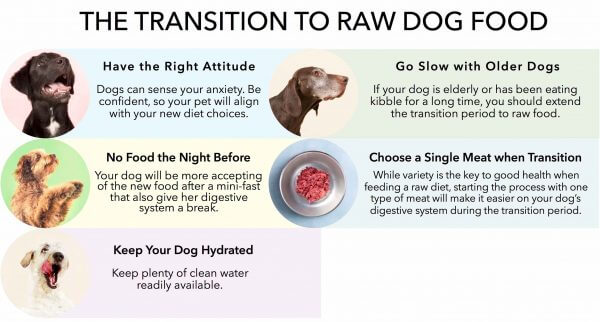
To find out more about making the transition to raw food, particularly for puppies and older dogs, check out Transitioning Your Dog to a Raw Food Diet.
How Much and How Often Should You Feed Raw Dog Food?
There are no hard-and-fast rules, but generally a typical adult dog should eat about two to four percent of her ideal body weight daily.
Here are some rules of thumb to determine feeding volumes:
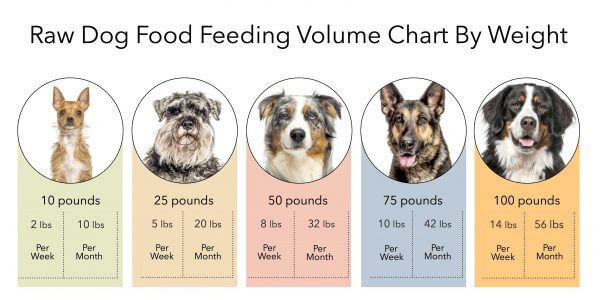
Recommended feeding amounts are simply suggestions. Every dog is unique and a factor in choosing food amounts is observing how much activity your companion packs into a day. Less than an ounce of food per meal may seem meager to you, but small dogs require very small portions. Then there’s simply thinking about how many calories your dog burns. Even dogs with a 15-pound size difference could potentially eat the same portion when you consider activity levels — one may run all day, whereas the other prefers lounging on the sofa. Dogs tend to need less food in the winter because they are less active.
The best way to keep your dog at the right weight? Be flexible. Monitor your dog’s weight regularly and adjust accordingly.
Where to Find More Raw Dog Food Guidance and Recipes
You can find books about raw food feeding and raw food recipes based on the Meat with Bone, B.A.R.F., or Prey/Ancestral Model diets at Dogwise. To answer questions about the specific dietary needs of your own pet, consider a consultation with a veterinarian affiliated with the American Holistic Veterinary Medical Association. You can also check Darwin’s Resource Center for a variety of topics related to feeding raw.
What to Look for in Raw Dog Food Brands
For dog ‘parents’ who don’t have time to prepare a homemade raw diet, there are excellent commercial alternatives available. Take some time to read labels, and if you’re still unsure, consult a veterinarian experienced in raw feeding or a raw pet food nutritionist.
“One of the more sneaky aspects of raw food is HPP: high pressure pasteurization. That process clearly devitalizes the protein and knocks out the enzymes, so the food is significantly different after the tremendous pressure it goes through to be preserved,” explains Dr. Falconer.
He also advises smart consumers to be aware of and check for:
- Recognizable species names, like chicken vs. poultry or beef vs. animal __ or meat __
- Absence of byproducts
- Bone included, the best source of calcium for your dog
- A short list of five to six ingredients vs. 14 or more
- Vegetation relatively low or last on the list; wolves don’t eat a lot of vegetation!
In addition to Dr. Falconers tips, here are some things to look for as you explore raw dog food brands for purchase:
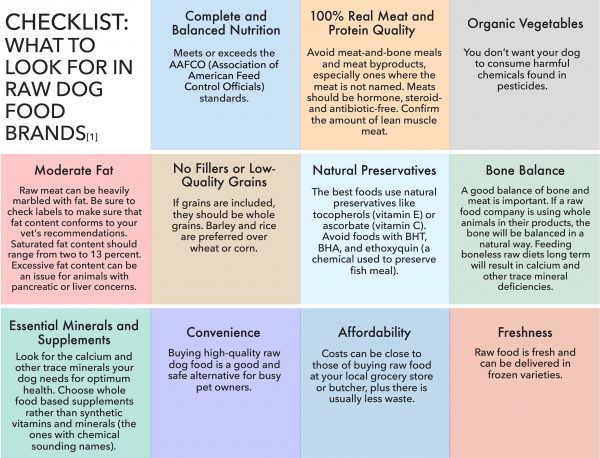
The Benefit of Frozen Raw Dog Food
The ultimate in raw food freshness is delivered via frozen varieties, particularly since you should freeze certain types of fish and meat to kill bacteria before feeding them to your dog. There are two other benefits of frozen dog food, in addition to safety and hygiene. First, it’s simply more convenient, since you can have it on hand when you need it and it doesn’t require much preparation. More importantly, you can be more confident that the contains all the nutrients promised on the label when you’re ready to use it.
To make it easier to decide which brand is right for you, we’ve created a comparison chart of the top brands. All the brands in this chart, make their food in the U.S. and all except Aunt Jeni’s Homemade Dinners use organic produce in their ingredients.
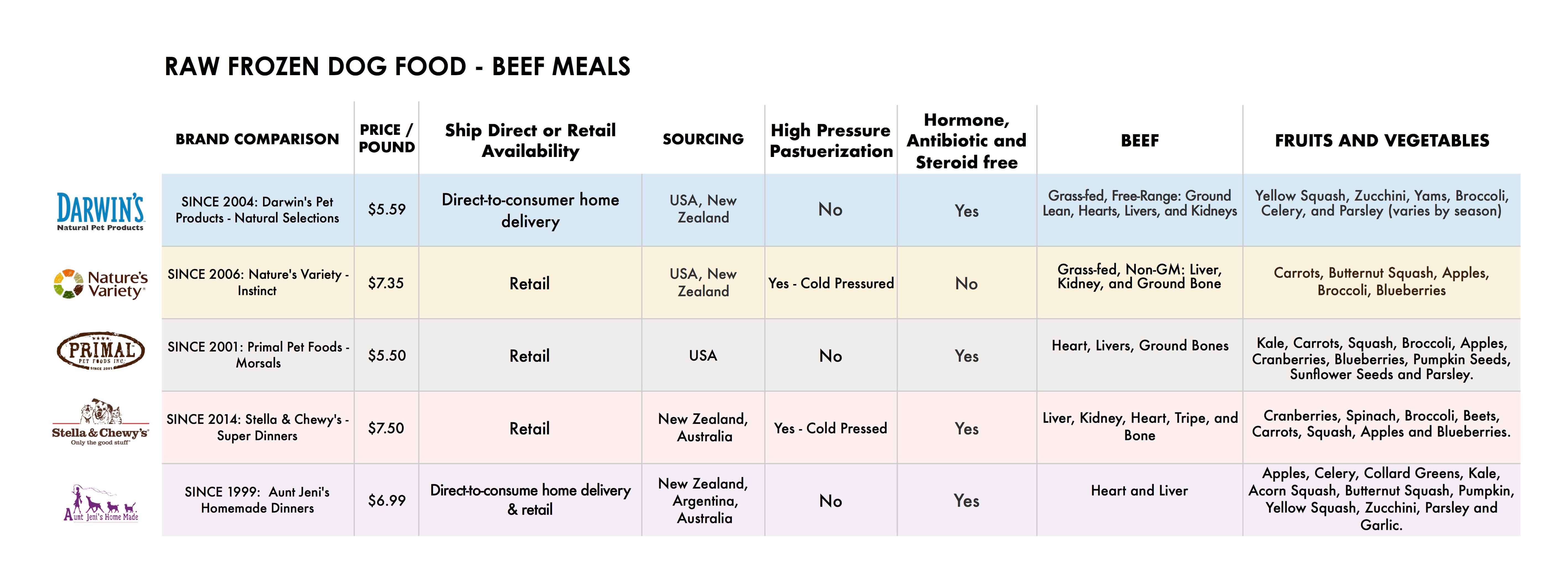
Take the Confusion out of Raw Feeding with a Free Menu Consultation from Darwin’s
Are you just getting started with raw feeding, or wondering if you’re taking the right approach for your pet? Darwin’s takes the confusion out of a raw food diet. Talk to one of our Menu Consultants, who are experienced dog nutrition experts, for guidance on just the right mix for your dog, including how to deal with canine medical issues such as allergies, digestive issues, weight control, and more.
Get started with a free menu consultation request or call 877-738-6325 for immediate assistance from a raw dog food professional.



